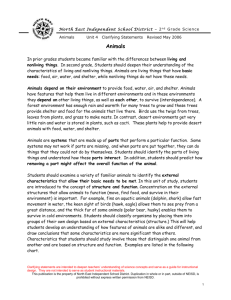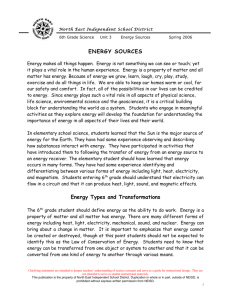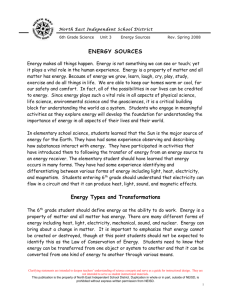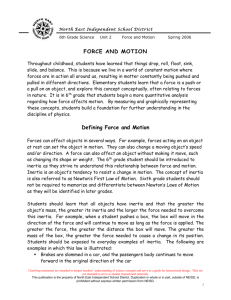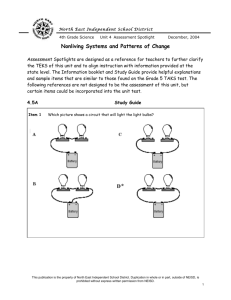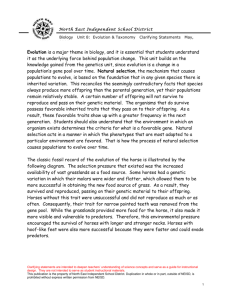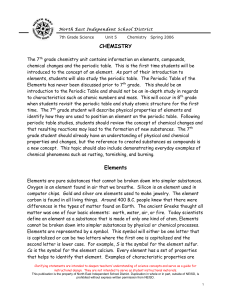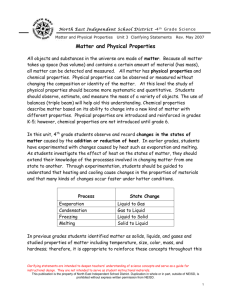7th grade Nature of Science - North East Independent School District
advertisement
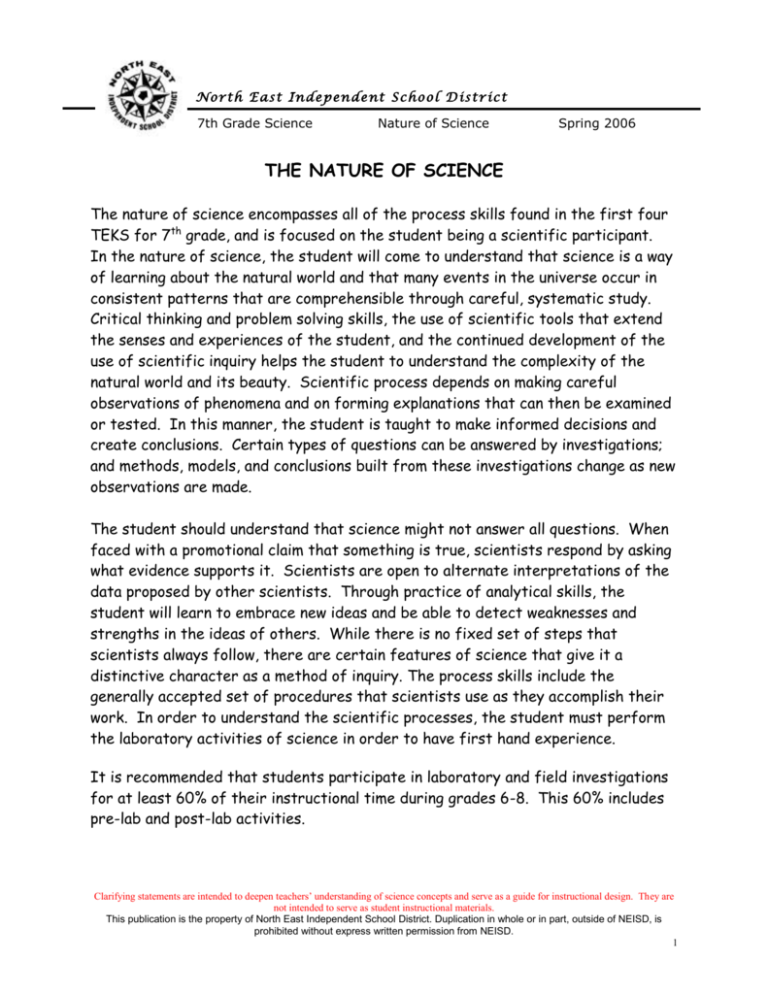
N o r th E a s t In d e pen d e nt S c ho o l Di s tr ic t 7th Grade Science Nature of Science Spring 2006 THE NATURE OF SCIENCE The nature of science encompasses all of the process skills found in the first four TEKS for 7th grade, and is focused on the student being a scientific participant. In the nature of science, the student will come to understand that science is a way of learning about the natural world and that many events in the universe occur in consistent patterns that are comprehensible through careful, systematic study. Critical thinking and problem solving skills, the use of scientific tools that extend the senses and experiences of the student, and the continued development of the use of scientific inquiry helps the student to understand the complexity of the natural world and its beauty. Scientific process depends on making careful observations of phenomena and on forming explanations that can then be examined or tested. In this manner, the student is taught to make informed decisions and create conclusions. Certain types of questions can be answered by investigations; and methods, models, and conclusions built from these investigations change as new observations are made. The student should understand that science might not answer all questions. When faced with a promotional claim that something is true, scientists respond by asking what evidence supports it. Scientists are open to alternate interpretations of the data proposed by other scientists. Through practice of analytical skills, the student will learn to embrace new ideas and be able to detect weaknesses and strengths in the ideas of others. While there is no fixed set of steps that scientists always follow, there are certain features of science that give it a distinctive character as a method of inquiry. The process skills include the generally accepted set of procedures that scientists use as they accomplish their work. In order to understand the scientific processes, the student must perform the laboratory activities of science in order to have first hand experience. It is recommended that students participate in laboratory and field investigations for at least 60% of their instructional time during grades 6-8. This 60% includes pre-lab and post-lab activities. Clarifying statements are intended to deepen teachers’ understanding of science concepts and serve as a guide for instructional design. They are not intended to serve as student instructional materials. This publication is the property of North East Independent School District. Duplication in whole or in part, outside of NEISD, is prohibited without express written permission from NEISD. 1 N o r th E a s t In d e pen d e nt S c ho o l Di s tr ic t 7th Grade Science Nature of Science Spring 2006 Science Process Skills The science process skills should not be taught in isolation, but should be embedded in the learning process of each and every unit throughout the year. The box below lists these process skills: Safety Use of Technology Constructing graphs, maps, etc. Using numbers and quantifying Interpreting data Experimental Design Thinking Critically Drawing conclusions Questioning Inferring Predicting Measuring Observing Use of Tools Science History Citing evidence Identifying Patterns Formulating hypotheses Analyzing Communicating Defining Operationally Use of Models Justifying Answers Identifying Variables Identifying variables is a skill many students struggle with. Variables are the values or quantities that change (vary) during an experiment. According to the 2006 TAKS Study Guide, middle school students should be able to identify the dependent (responding) variable, the independent (manipulated) variable, and controlled variables in an experiment. Scientific Tools The 7th grade student is required to collect and analyze information using beakers, Petri dishes, meter sticks, graduated cylinders, weather instruments, hot plates, dissecting equipment, test tubes, safety goggles, spring scales, balances, microscopes, telescopes, thermometers, calculators, field equipment, computers, computer probes, timing devices, magnets, and compasses. Purple indicates tools introduced at 7th grade. Tools are used to promote the scientific understanding of the tool and its use. The use of equipment, outlined in TEKS 8.4A, will be assessed on the middle school TAKS test. Students should not only be able to identify which tool should be used Clarifying statements are intended to deepen teachers’ understanding of science concepts and serve as a guide for instructional design. They are not intended to serve as student instructional materials. This publication is the property of North East Independent School District. Duplication in whole or in part, outside of NEISD, is prohibited without express written permission from NEISD. 2 N o r th E a s t In d e pen d e nt S c ho o l Di s tr ic t 7th Grade Science Nature of Science Spring 2006 for a particular purpose, but should also be able to explain how to use that tool. For example, students should know that switching the objective lens on a microscope will make the object being viewed larger while turning the fine adjustment knob will bring the object into focus. In addition, students should have an understanding of units used on tools for measurement. For example, students should know that each mark on their centimeter TAKS ruler represents one millimeter. Representing the Natural World with Models Models are tools for understanding the natural world and can show how systems work. The student should understand that models are used to study objects and events whose size and scope may make them difficult to study or explain. Students should be provided frequent opportunities to work with models. It is critical that students understand that models are not perfect representations and have limitations. Teachers should facilitate conversations about the advantages of using a model to represent the natural world. Conversations must include an understanding of the limitations of the model, including how the model could be modified to more accurately reflect what it represents. Based on new discoveries, models are constantly being modified to more closely reflect the natural world. There are three different types of models. Students should not be required to memorize these types, but they should be aware there are multiple ways to represent the natural world. Throughout the year, students should be exposed to the following types of models: Physical model (example: classroom skeleton for human body study ) Mathematical model (example: Work = force × distance) Conceptual model (example: food chain energy pyramid) Clarifying statements are intended to deepen teachers’ understanding of science concepts and serve as a guide for instructional design. They are not intended to serve as student instructional materials. This publication is the property of North East Independent School District. Duplication in whole or in part, outside of NEISD, is prohibited without express written permission from NEISD. 3 N o r th E a s t In d e pen d e nt S c ho o l Di s tr ic t 7th Grade Science Nature of Science Spring 2006 History of Science and Contributions of Scientists True scientific work involves many individuals doing many different kinds of work and goes on to some degree in all nations of the world. Men and women of all ethnic and national backgrounds participate in science and its applications. Students in middle school will be exposed to the importance of scientific history and the value of contributions by scientists. The following list contains suggestions for topics in the history of science that are aligned to the 7th grade curriculum. It should be understood this is not an exhaustive list, and there may be other scientists or topics teachers wish to discuss with students. Newton – force and motion studies Archimedes – simple machines, including function of the lever Mendeleev – organization of the periodic table Various advances in medicine and understanding of the human body including transplants, vaccines, and scientists such as Salk, Pasteur and Fleming Pavlov – simulation of stimulus-response Mendel, Watson and Crick – heredity Darwin – natural selection Jane Goodall – ecology studies Clarifying statements are intended to deepen teachers’ understanding of science concepts and serve as a guide for instructional design. They are not intended to serve as student instructional materials. This publication is the property of North East Independent School District. Duplication in whole or in part, outside of NEISD, is prohibited without express written permission from NEISD. 4
